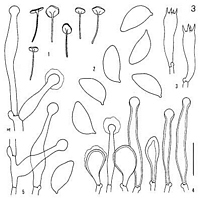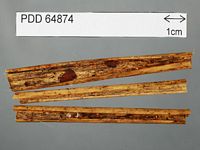|
 Gloiocephala tibiicystis Gloiocephala tibiicystis
BiostatusPresent in region - Indigenous. Endemic
Images (click to enlarge)
Caption: Gloiocephala tibiicystis Horak & Desjardin (CANB, holotype): 1, basidiomes (x2);
2, basidiospores (X2000); 3. basidia (xl000);
4, pileipellis with pilocystidia (xl000);
5, caulocystidia (xl000) | 
Caption: Dried type specimen
Owner: Herb PDD |
Article: Horak, E.; Desjardin, D.E. (1994). Reduced marasmioid and mycenoid agarics from Australasia. Australian Systematic Botany 7: 153-170.
Description: Pileus to 4 mm diam., hemispherical, becoming
convex to flat expanded, whitish, minutely pruinose to velutinous (under hand-lens),
dry, tough. Lamellae none, hymenophore smooth or with few venose radial folds.
Stipe to 8 X 0.3 mm, central to slightly eccentric, cylindrical, slender, horse-hair-like,
apex whitish, dark brown to black towards base: apex pruinose, becoming smooth
downwards, dry, elastic, solid, solitary in groups, insititious (basal disc
or byssus absent). Odour absent. Basidiospores 10-1 I X 5-5.5 µm, broadly fusoid
to subamygdaliform, inequilateral in profile, smooth, hyaline, inamyloid. Basidia
25-35 X 8-9 µm, tetrasporic, subclavate (to cylindric), sterigmata up to 4 µm
long, clamped. Hymenial cystidia absent or rarely encountered towards the margin,
shape and size as caulocystidia. Pileipellis hymeniform, composed of slender
clavate or vesiculose, non-diverticulate cells 20-25 X 8-18 µm, thick-walled
(1-3 µm) especially at apex, hyaline, often encrusted with orange-brown pigment
(in KOH). Pilocystidia numerous, 30-55 X 4-8 µm, slender fusoid with capitate
apex (3-6 µm diam.), thick-walled except at globose apex, hyaline, tips occasionally
bearing a resinous drop. Oleiferous hyphae absent. Stipe tissue monomitic. Stipe
cortical hyphae 3-8 µm diam., parallel, smooth, non-gelatinous, hyaline, inamyloid,
clamped. Caulocystidia numerous, 30-45 X 5-9 µm, shape like pilocystidia or
typically tibiiform to lecythiform, globose apex 6-8 µm diam., often with resinous
cap, thin-walled (< 1.5 µm diam.), hyaline.
Habitat: On rotting leaves of Phormium tenax
J.R. & G. Forst. (Phormiaceae). Known from North Island of New Zealand.
Notes: Gloiocephala tibiicystis belongs in sect. Gloiocephala subsect. Gloiocephala where it is allied
with G. mycenoides Singer (1969) and G. epiphylla Massee (1892),
The Chilean G. mycenoides differs in forming a densely pubescent, entirely
white stipe covered on the base with filiform caulocystidia (and hence the specific
epithet), and in forming large conspicuous hymenial cystidia and consistently
thin-walled pilocystidia (SGO, holotype!). Gloiocephala epiphylla differs
in forming distinctly narrower basidiospores (3.2-4.4 µm diam.), much larger
pilocystidia (up to 180 µm long with capitate apex up to 26 µm diam.), and much
longer caulocystidia (up to 120 µm long).
|